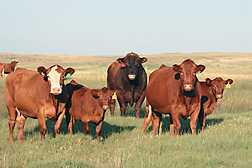This page has been archived and is being provided for reference purposes only. The page is no longer being updated, and therefore, links on the page may be invalid.
| Read the magazine story to find out more. |
|
|
Test Identifies Red Angus Carriers of Bone Disease
By Sandra AvantSeptember 29, 2011
A new test that detects a rare and deadly bone disorder in Red Angus is now available to cattle producers, thanks to U.S. Department of Agriculture (USDA) scientists.
Marble bone disease, also known as osteopetrosis, had not been seen in the United States since the 1960s until it resurfaced in Red Angus cattle three years ago. The birth defect, which affects humans, cattle and other animals, causes abnormal brain and bone marrow cavity development, leading to overly dense, brittle bones. Calves with the mutation usually are stillborn or die soon after birth.
To stop the disease in cattle, scientists at the Agricultural Research Service (ARS) Roman L. Hruska U.S. Meat Animal Research Center (USMARC) in Clay Center, Neb., and the Henry A. Wallace Beltsville Agricultural Research Center (BARC) in Beltsville, Md. collaborated with several university and Red Angus Association of America partners to identify the gene mutation responsible for the disorder. They then developed a DNA diagnostic test that identifies osteopetrosis carriers.
ARS is USDA's chief intramural scientific research agency, and this research supports USDA's priority of promoting international food security.
Chemist Tim Smith and geneticist Tara McDaneld in the USMARC Genetics and Breeding Research Unit, BARC geneticist Tad Sonstegard and University of Illinois scientists compared DNA from affected Red Angus calves and their carrier parents to unaffected animals. A search of the entire genomes of all the calves for common and uncommon chromosomal segments revealed an abnormality.
In osteopetrosis-affected calves, some of the genetic material of SLC4A2, a gene located on a segment of chromosome 4, had been deleted. The discovery of the deletion was a first for cattle, according to McDaneld. SLC4A2 is necessary for proper osteoclast maintenance and function. Osteoclasts are cells that break down old bone during bone development and remodeling.
Scientists were able to develop a polymerase chain reaction test in less than a year, according to Smith. The test is being used to help manage osteopetrosis and identify possible carriers.
Findings from this research were published in Biomed Central Genomics.
Read more about this research in the September 2011 issue of Agricultural Research magazine.


